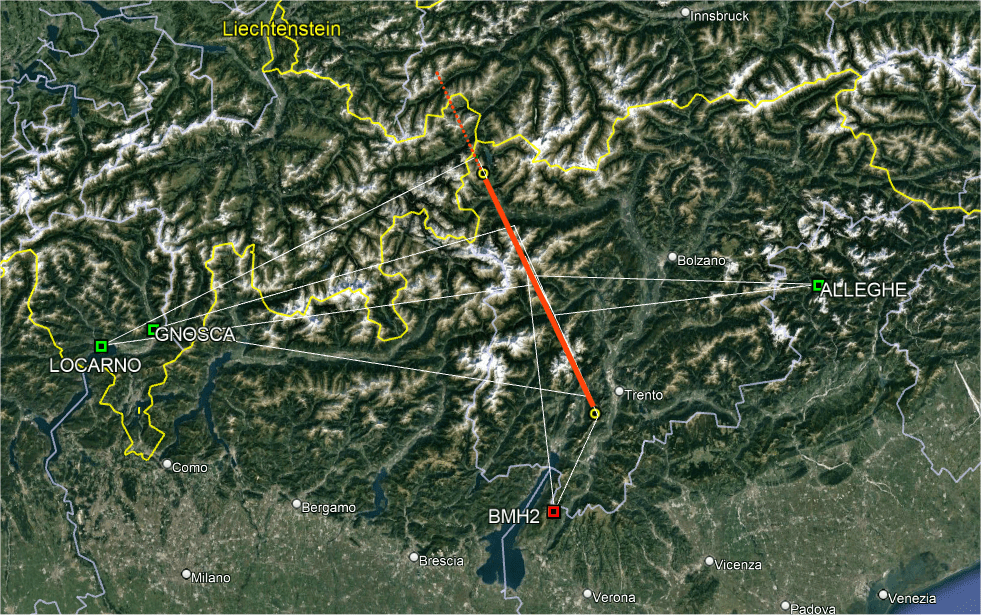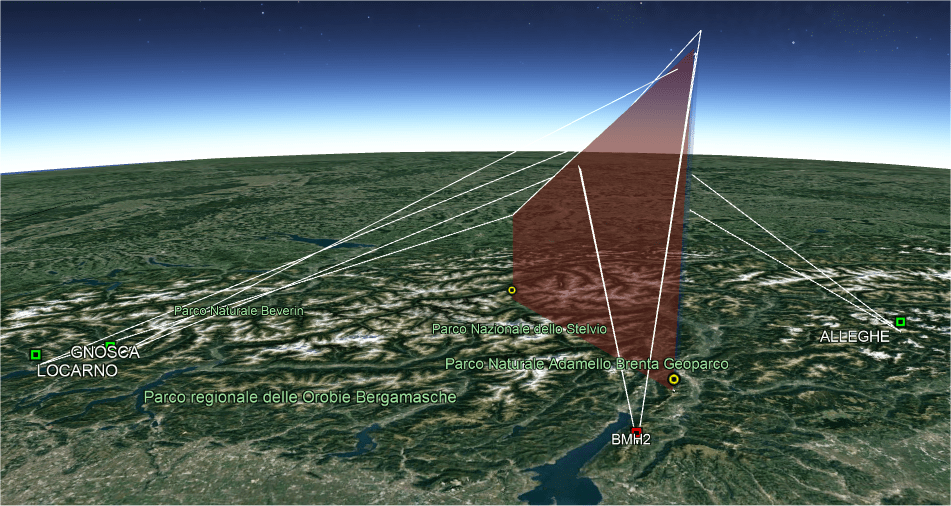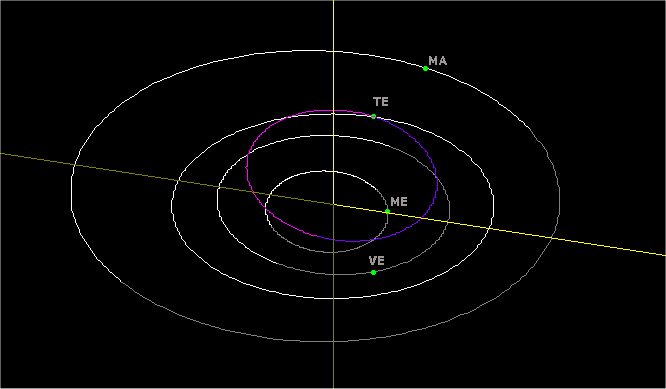By Enrico Stomeo and Stefano Crivello
Abstract: A brilliant meteor, captured by 4 video cameras, was observed in northern Italy on 22 December 2022 at 03h39m UT. The trajectory of the meteoroid was determined together with its orbit in the Solar System.
Introduction
This meteoroid entered the atmosphere on 22 December 2022 at 03h39m46s UT between the Adamello and Stelvio national parks with a trajectory roughly from SSE to NNW (mean azimuth N_154°E), producing a spectacular bolide of video magnitude –8 or so. The event was observed from all surrounding regions that had no haze or cloud cover at the time.
The brilliant meteor showed a progressive increase in brightness, revealing a persistent trail even before halfway, as well as two almost consecutive explosions.
Observational data
Four stations filmed the event[1], one from our monitoring network Italian Meteor Group/ UAI-Sezione Meteore[2], two from the SAT Società Astronomica Ticinese and a webcam from the Alleghe cableway station at Piani di Pezzé (Figures 1 to 4).

Figure 1 – © Maurizio Carli – Italian Meteor Group – UAIsm / IMO Video Meteor Network.

Figure 2 – © Stefano Sposetti – Beobachtungsstation Locarno (Switzerland).

Figure 3 – © Stefano Sposetti – Astronomical Observatory of Gnosca (Switzerland).

Figure 4 – © Webcam of Alleghe cableways at the Pezzè plateau (courtesy of Giuseppe De Donà).
The triangulation results
The image in Figure 5 shows the ground projection of the atmospheric path of the fireball between the two yellow dots as well as the viewing directions of the individual stations. A dotted line shows the possible continuation of the trajectory, after the meteor’s luminosity had ended.
An evaluation of the available data shows that the meteoroid was observed entering the atmosphere with an average speed of 14.6 km/s, an average inclination of 30.5°, and that the meteor became visible at an altitude of 84. 4 km above the mountains 12.6 km north of Rovereto (46.01°N, 11.04°E), ending at a height of about 28.6 km above the mountains 1.4 km west of Lago della Muta (46.75°N, 10.51°E), covering a trajectory length of about 128 km.

Figure 5 – Ground projection of the bolide’s atmospheric path.
It can be seen in Figure 5 that none of the four stations filmed the entire trail. BMH2 captured the first part of the atmospheric trajectory up to about halfway for 4.28 seconds. Being close, it saw the persisting trail begin at about 79 km height and the gradual increase in brightness culminating in two almost consecutive flares at about 60 and 59 km height. At an altitude of about 51 km, the fireball exited the camera field after having moved over a distance of 64 km.
A decisive contribution to the analysis of this bolide was made by the two Swiss stations, as their video data provided information on the final phase of the meteor, but unfortunately not on the frame-by-frame values of the velocity. Thus, only the deceleration (about 2 km/s) deduced from BMH2 up to about 52 km above the ground was evaluated, but not the lower part of the final atmospheric path. GNOSCA saw the fireball start a few moments after BMH2, following the path for 4.88 seconds until it left the field of view, when the meteor was about 46 km high. LOCARNO, on the other hand, filmed the bolide for 5.02 seconds from about halfway, i.e., from entering the field of view, to the end of the meteor at a height of 28.6 km. The ALLEGHE cableway webcam filmed the bolide from the east, only in its central part for about 18 km.

Figure 6 – Geometry of the bolide’s trajectory as seen from the south.

Figure 7 – The most probable orbit of the meteoroid resulting from the best triangulation.
Orbital elements
The best solution indicates the radiant at α = 178.3° and δ = –10.2° (eq.2000) between the constellations of Virgo and Crater. No association with known meteor showers could be established. The other most relevant values describing the orbit of the meteoroid are summarized below, based on the available data: geocentric radiant and velocity: αg = 181.6° δg = –22.6° and vg = 9.2 km/s, radiant heliocentric radiant and velocity αh = 355.8° δh = –8.2° and vh = 22.1 km/s. Orbital elements (Figure 7): a = 0.673 AU, q = 0.361 AU, e = 0.465, ω = 185.01°, Ω = 89.96°, i = 8.28° (eq.2000). A comparison of the orbit found with that of known cometary and asteroidal objects indicates a possibility (DSH = 0.13, Southworth and Hawkins (1963)) of similarity with the orbit of asteroid 348306 (2005 AY28).
Acknowledgements
Special thanks to Giuseppe De Donà for providing the Alleghe webcam image and to Alberto Latini for contacting the stations across the border.
References
Ceplecha Z. (1987). “Geometric, dynamic, orbital and photometric data on meteoroids from photographic fireball networks”. Bull. Astron. Inst. Cz., 38, 222–234.
Southworth R. B. and Hawkins G. S. (1963). “Statistics of meteor streams”. Smithsonian Contributions to Astrophysics, 7, 261–285.
[1] Video station BMH2, Obs: Maurizio Carli (mt Baldo, VR). Video station GNO, Obs: Stefano Sposetti (Gnosca, Switzerland). Video station LOC, Obs: Stefano Sposetti (Locarno, Switzerland). Webcam Alleghe cableways at Piani di Pezzé (BL).
[2] Italian Meteor Group – UAI Sezione Meteore http://meteore.uai.it.




